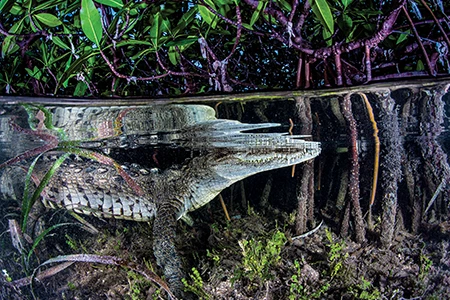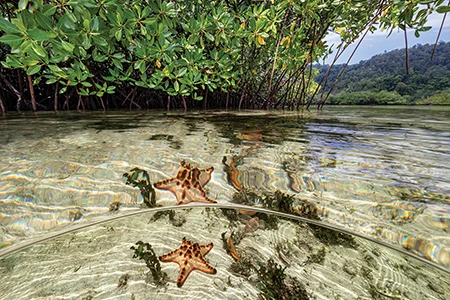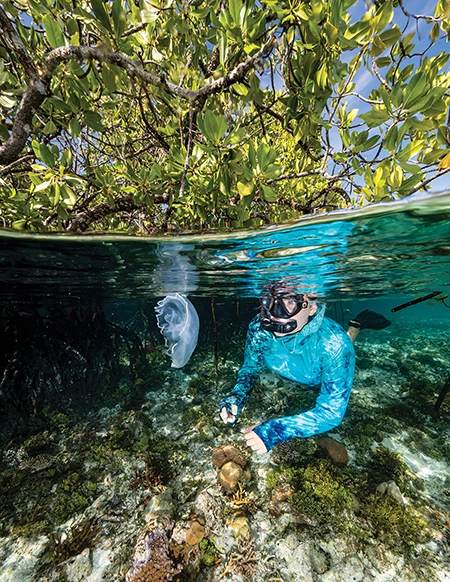Shoreline Guardians
Mangroves matter. They are unique, complex habitats that guard shorelines. They connect the land to the sea, house a diverse range of animal and plant life, and reduce the impacts of climate change. But for all their importance, mangroves remain largely underappreciated.
Hurricane Katrina made me start considering their benefits. During the late summer of 2005, shortly after completing my open-water certification, I watched as the news was full of predictions and suspense as Hurricane Katrina crawled toward New Orleans, Louisiana. It hit land as a Category 5 storm with winds around 140 miles per hour (225 kilometers per hour), bringing an unanticipated and unimaginable fury.
The effects were catastrophic, leading to almost 1,400 deaths and nearly $200 billion in damage, making it the costliest hurricane in U.S. history. Katrina’s powerful winds and ocean surge led to widespread destruction and levee failure, submerging 80% of the city and leaving behind a sobering high-water mark. While the offshore environment did not protect New Orleans from Katrina, mangroves have lessened storm damage in other instances.


Mangroves as a Buffer
Mangroves are a part of the natural barriers against coastal storms, helping to minimize the impact of flooding caused by hurricanes, typhoons, and cyclones. The extensive tangled root systems of mangroves help bind sediment, reduce erosion, and stabilize shorelines. Research shows that mangroves dissipate wave energy and slow storm surge penetration, which can lower flood damage and minimize erosion.
Studies have demonstrated that mangroves can reduce a large portion of wave energy along shorelines. The width of mangrove areas seems to be a significant factor in coastal protection, with thicker forests offering more protection. The added buffer of mangroves should reduce flooding and ward off billions of dollars in damages for several million people globally each year. Unfortunately, because of climate change, coastal development, and population growth, coastal flood risks are rising rapidly.
It is important to note that mangroves cannot wholly reduce the hazards from tropical storms and provide the only form of coastal defense. The World Bank reports that mangroves can help reduce coastal risks by acting as a natural barrier against storm surges and erosion, but they should be used in conjunction with other coastal protection strategies such as engineered defenses, early warning systems, and careful land-use planning to ensure dwellings aren’t located in high-risk areas.


Mangroves as Life Cycle Support
The importance of mangrove forests extends beyond shoreline stability. Serving as a crucial marine habitat is one of their most well-known benefits. Mangroves are often referred to as nurseries — while acting as a shelter from predators and currents, they house a diversity of juvenile fishes and other marine animals, such as turtles, sharks, crocodiles, manatees, birds, and snakes.
The critically endangered goliath grouper, for example, remains in its mangrove nursery for up to six years, leaving only after it has grown to approximately 3.3 feet (1 m) in length. Some animals, such as crocodiles, may never leave mangrove habitats due to their continuous shade, nesting areas, and abundant food, including fish, crabs, and birds. Likewise, several endangered species — such as the smalltooth sawfish, manatee, Cuban crocodile, and hawksbill sea turtle — rely on the mangrove habitat for some of their life cycle.
Mangroves are critical components of food webs because of their animal predator–prey relationships and because they produce large amounts of leaves that drop from the trees and decompose via fungi and bacteria. This decomposed matter, called detritus, provides a plentiful food supply to some growing marine animals.
In addition to housing so many diverse marine organisms, mangroves also provide large quantities of seafood. According to the International Union for Conservation of Nature (IUCN), more than 200 million people live within 33 feet (10 m) of sea level and near mangroves. People living in or near coastal communities have a routine source of protein to feed their families or to sell to make a living. Subsistence fishers rely on healthy mangrove systems for their nursery function, which allows them to have a continuous supply of reef-harvested species, such as snapper.


Mangroves as Blue Carbon
Mangrove forests are among the most productive ecosystems worldwide. Many people are surprised to learn that mangrove forests store high amounts of carbon. Conservation International reports that mangroves hold as much carbon in a single square mile (2.6 sq km) as the annual emissions of 90,000 cars.
Mangrove forests capture massive amounts of carbon dioxide from the atmosphere and store it in their carbon-rich roots and soils. This buried carbon is known as blue carbon because it is stored underwater. In scientific terms, coastal blue carbon is the carbon captured by living coastal and marine organisms and stored in coastal ecosystems. These types of habitats, which sometimes act as carbon sinks, contain huge stores of carbon accumulated over thousands of years.
Current studies by the National Oceanic and Atmospheric Administration (NOAA) suggest that mangroves and coastal wetlands annually sequester carbon at a rate 10 times greater than mature tropical forests and store three to five times more carbon per equivalent area than tropical rainforests, which store most carbon in above-ground plant materials. Coastal blue carbon, however, is primarily stored in the soil or sediments. Mangroves are adapted to live in anaerobic (without oxygen) soils, so the carbon that gets incorporated into the soils decomposes very slowly and can remain in place for hundreds to thousands of years.
When mangroves are degraded or destroyed, their carbon sequestration capacity is lost, and the stored carbon is released as carbon dioxide when the soil is disturbed, increasing levels of greenhouse gases in the atmosphere and contributing to climate change. The U.S. Environmental Protection Agency reports that carbon dioxide accounts for 76% of greenhouse gas emissions, most of which come from industrial processes such as burning fossil fuels. As we face a rise in carbon emissions and a warming planet, this critical role in sequestering and recycling carbon is even more important to help offset and reduce the effects of climate change.
Mangrove Ecotourism
Ecotourism has become one of the most effective tools to promote environmentally sound and culturally sensitive tourism. Likewise, the potential of ecotourism for promoting resource conservation and community development has drawn more attention over the past decade.
One of the most appreciable attributes of healthy mangrove forests is their natural beauty, especially in pristine habitats. Some tourists seek mangrove excursions because the trees are easy to view while boating, kayaking, or snorkeling due to their shallow depth. They also make perfect places to photograph wildlife in and out of the water. While corals, fish, turtles, sharks, and crustaceans populate the underwater environment, birds, crabs, and lush vegetation thrive above the waterline.

For photographers, mangrove forests offer infinite opportunities to capture unique images that reward creativity. Since mangrove forests lie within shallow waters, ample light is available, making photography easier. These shallow locations also make ideal spots to practice over-under shots, which best capture the fascinating subject matter above and below the waterline. Plus you don’t need scuba to explore the mangroves, so you can conveniently snorkel there as a surface interval between dives.
Mangrove ecotourism can help conserve mangroves and improve the lives of local communities. Increased income from ecotourism can lead to infrastructure development, improved environmental awareness, and sustainable tourism. By having local people lead ecotourism activities such as providing guided tours, they can earn money while helping to ensure the conservation of biodiversity.
Mangrove Degradation
While mangrove forests are among the most productive ecosystems on Earth, they are also among the most vulnerable due to increasing human development. According to EcoWatch, mangrove forests are vanishing at 1% to 2% per year. This rate of loss may not sound alarming, but it adds up.
Conservation International reports that roughly 35% of the world’s mangroves have disappeared since 1980. Scientists estimate that carbon emissions from mangrove deforestation account for up to 10% of emissions from deforestation globally despite covering just 0.7% of land areas.
According to the Global Forest Resources Assessment (FRA) of 2020, global mangrove coverage is estimated to be 36.6 million acres (14.8 million hectares). While Indonesia contains the highest percentage of the world’s mangrove coverage at 22%, more than 40% of the world’s mangroves are located in just four countries: Indonesia, Brazil, Nigeria, and Mexico. The FRA reported that between 1990 and 2020 mangroves decreased by 2.57 million acres (1.04 million hectares) worldwide, and up to 1.98 million acres (800,000 hectares) were lost in Indonesia alone over the past 30 years.
One of the primary reasons for the large-scale loss of mangrove habitats is land clearing, primarily when done for coastal development projects and aquaculture practices such as shrimp farming. The World Wildlife Fund states that shrimp production has a larger carbon footprint than most other seafood; it has destroyed millions of acres of mangroves and has excessive waste that pollutes waterways.
It takes approximately three to six months to raise market-sized shrimp in ponds that produce a constant stream of organic waste, including chemicals and antibiotics that can pollute coastal wetlands and groundwater that can, in turn, seep onto agricultural land, having longstanding negative effects.
Scientists at Global Mangrove Watch conducted a study to analyze changes in mangrove ecosystems in the world from 1996 to 2010 and found that human activity affected 38% of mangrove forests observed in Southeast Asia. This area is home to roughly 34% of the world’s mangroves and 90% of the world’s aquaculture, making it the most highly impacted region.
Land clearing also has direct impacts on the ocean. The ocean absorbs about 30% of the carbon dioxide in the atmosphere, but deforestation and human activity increase the amount of carbon absorbed by seawater, leading to ocean acidification. This process makes it more difficult for marine organisms to build shells and skeletons and can lead to harmful toxic algae blooms.
Mangrove Restoration
Conserving and rehabilitating mangrove forests could benefit millions of coastal people and contribute to increased carbon sequestration worldwide. Mangrove restoration has become a widely discussed topic and focus of international environmental targets.
Along with the United Nations Decade of Ecosystem Restoration 2021-2030, the global community has strongly committed to increasing mangrove coverage by 20% by 2030. Achieving this goal could help reduce carbon in the atmosphere and the effects of climate change.
A 2023 article in Nature Ecology and Evolution by Sasmito et al. reports that Indonesia, which contains the largest single-nation mangrove forest coverage in the world, has created the most ambitious mangrove rehabilitation plan of any country, which includes adding 1.48 million acres (600,000 hectares) by the end of 2024. This plan could benefit 74 million coastal people and help reduce the national land-sector emissions by 16%.
People and organizations engage in restoration activities to try to compensate for mangrove degradation. In most cases mangrove restoration is approached like planting trees in a forest. Mangrove seedlings are transplanted to mudflats along the coastline, especially in areas where mangroves previously flourished. Many of these projects, however, suffer from low success rates for various reasons.
First, mangrove seedlings are more fragile than terrestrial seedlings, as they are exposed to changing tides and submerged in water for periods of time. If the water level is not optimal, seedlings have a low survival rate. According to studies by Florida scientist Robin Lewis, an ichthyologist who developed an interest in wetlands, most mangroves do best with a 30–70 wet-to-dry ratio, with their roots wet 30% of the time and dry 70% of the time. Replicating this natural hydrology greatly increases the chance of seedling survival.
Transplants typically use only one mangrove species, while native mangrove forests are a mix of numerous species. If restoration efforts are not carefully planned to match the historical forest structure and zoning, then the overall biodiversity may be lower, and thus the forest could be less stable.
Lewis also learned that seedlings do best in the conditions that Mother Nature intended, not necessarily in organized, single-species rows. He recommends mapping the area’s water movement and then removing significant amounts of dirt and constructing a large, slightly sloping area leading to the ocean, where tides can flow.
Although time-consuming, Lewis’ methods have proven successful. Between 1989 and 1991 in West Lake Park, Florida, all three of Florida’s mangrove species had established themselves with adult and juvenile fish diversity resembling an older, natural mangrove site nearby. Lewis’ restoration methods have been used to restore mangroves in the U.S. and 25 other countries, including Indonesia.
Looking to the Future
Although Lewis’ methodology proved successful, it’s important to recognize that mangrove forest ecosystems vary by location in terms of plant species, tide movements, water temperature, chemical composition, and many other factors. What is successful in one location may not be in another. Furthermore, many hand-planted mangrove forests are showing promise.
In May 2024 I had the opportunity to visit the Mahonia Na Dari mangrove restoration center in Kimbe Bay, Papua New Guinea, which is adjacent to the Walindi Plantation Resort. This ecological center started in 1996 and aims to restore mangrove forests along its coastline. Twenty years ago there were no mangroves here. In 2017 and 2021, volunteers (mostly students from local schools) transplanted seedlings from nearby sites to this location, which is now about 984 feet (300 m) long and at least 164 feet (50 m) wide.
The mangroves are currently growing and developing at a healthy rate. Governmental agencies funded the project, as this area contains palm oil plantations, and it is believed that installing a barrier between the palm oil trees and the sea will be beneficial to the plantation itself and to the nearby coral reefs.
There is hope that the collective actions of groups of people can bring about positive change. The work done by people like Lewis and the volunteers at Mahonia Na Dari are real-life examples of what we can accomplish with forward thinking and a goal in mind.
“It is not at all unreasonable to think about increasing the amount of mangroves,” Lewis said. “Even with sea level rise, we could actually stop the loss, … so we really need to get to work.”
Mangrove forests have acted as shoreline guardians for thousands of years. Although New Orleans still suffered catastrophic loss, communities around the Indian Ocean that faced tsunamis and those in Florida that dealt with Hurricane Irma saw the impacts of these weather events lessened in part because of the mangroves.
With climate change altering our planet and major storms becoming the norm and not the exception, it is increasingly crucial that we do everything we can to preserve these unique ecosystems for future generations.
Explore More
Learn more about the importance of mangroves in these videos and research article.
© Alert Diver – Q4 2024